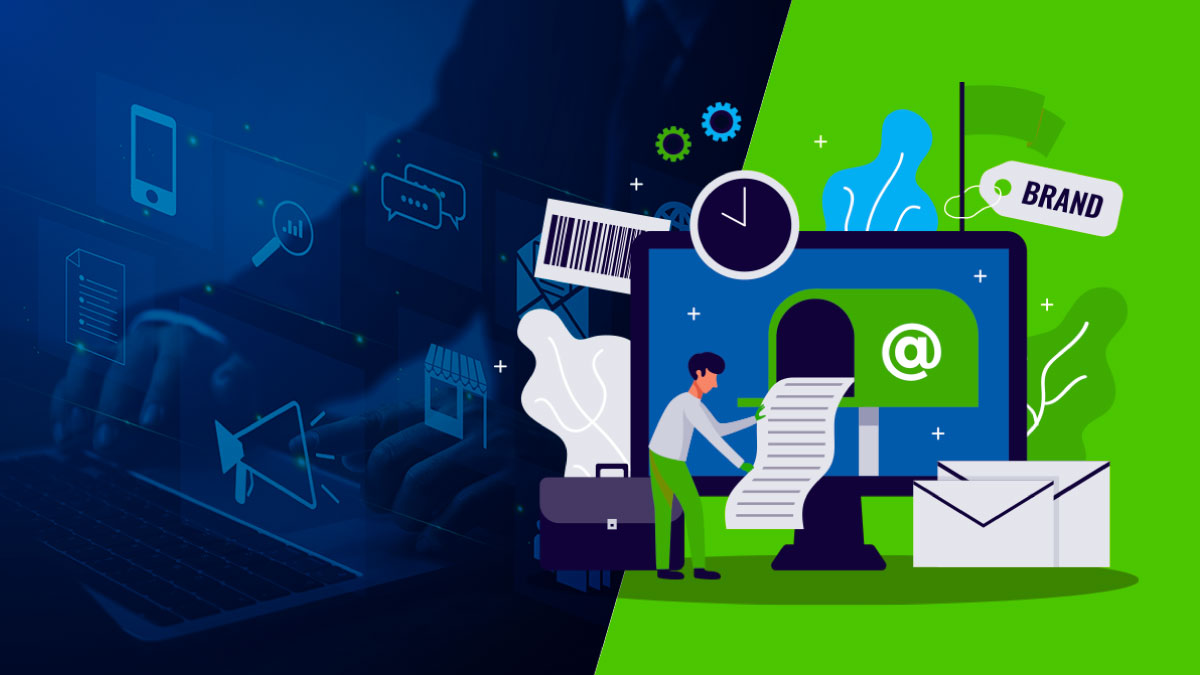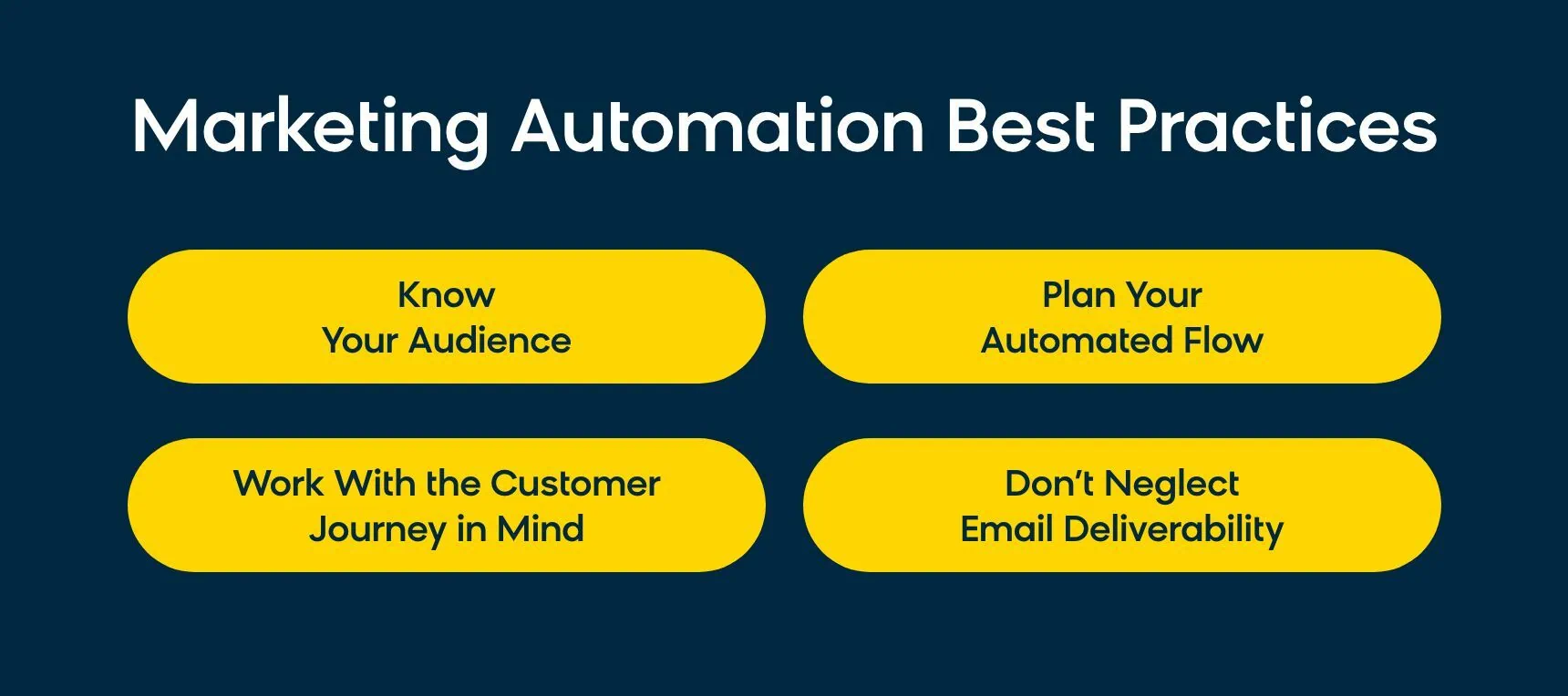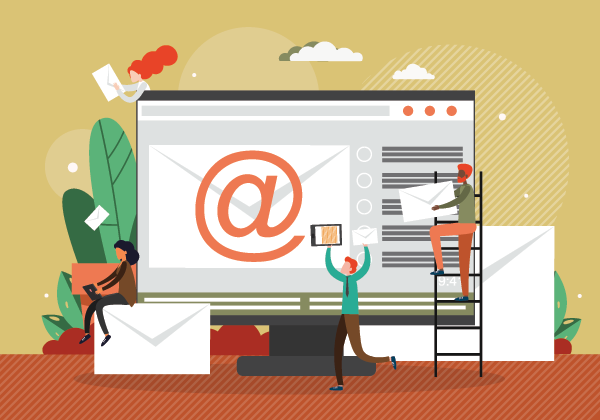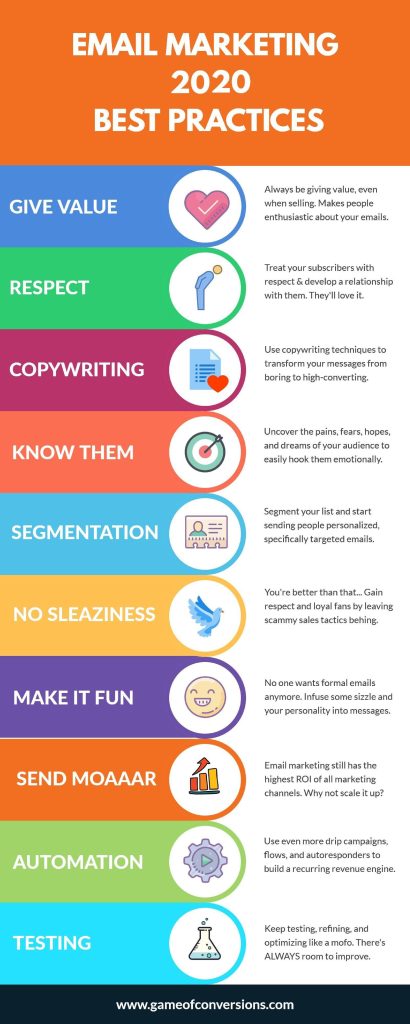Email marketing automation can transform your business communication. It helps save time and increase engagement.
In today’s fast-paced digital world, staying connected with your audience is key. Email marketing automation simplifies this task, allowing you to send personalized messages effortlessly. It boosts your marketing efforts, ensuring your emails are timely and relevant. With the right strategies, you can nurture leads, retain customers, and drive sales effectively.
This blog explores the best practices for email marketing automation. You’ll learn how to optimize your campaigns, keep your subscribers engaged, and measure your success. Dive in to discover how you can leverage email automation to achieve your marketing goals. Let’s get started!

Credit: www.blueatlasmarketing.com
Introduction To Email Marketing Automation
Email marketing automation can make your marketing efforts much more efficient. With automation, you can send the right message to the right person at the right time. This can lead to higher engagement and conversions.
What Is Email Marketing Automation?
Email marketing automation involves using software to send emails based on specific triggers. These triggers can be user actions, such as signing up for a newsletter or making a purchase. The software can send personalized emails without manual effort.
For example, if a user abandons their shopping cart, an automated email can remind them to complete the purchase. This process saves time and ensures timely communication with your audience.
Benefits Of Automation
- Time-saving: Automation reduces the need for manual email sending.
- Personalization: You can send personalized emails based on user behavior.
- Consistency: Automated emails ensure consistent communication with your audience.
- Higher engagement: Timely and relevant emails can lead to higher open and click rates.
- Scalability: Automation allows you to manage large email lists efficiently.
Setting Clear Goals
Setting clear goals is essential for effective email marketing automation. Clear goals guide your strategy and help you measure your success. Without clear goals, your efforts may lack direction and focus. Below, we will discuss how to define objectives and measure success in email marketing automation.
Defining Objectives
Start by identifying what you want to achieve. Do you want to increase sales, boost engagement, or grow your subscriber list? Each goal requires a different approach. Be specific. For example, aim to increase sales by 20% in three months. This clarity helps in creating targeted campaigns. Use data from past campaigns to set realistic goals. Understand your audience’s needs and preferences. Tailor your objectives to meet these needs.
Measuring Success
Once you set your goals, decide how to measure success. Use key performance indicators (KPIs) that align with your objectives. For increasing sales, track metrics like conversion rates and revenue. For engagement, monitor open rates and click-through rates. Set benchmarks and compare your results against them. Use analytics tools to gather data and insights. Regularly review your performance to stay on track. Make adjustments as needed to improve your results.
Segmenting Your Audience
Segmenting your audience is a crucial aspect of email marketing automation. By dividing your audience into smaller groups, you can send more targeted and relevant messages. This approach enhances engagement, increases open rates, and boosts conversions.
Importance Of Segmentation
Segmentation helps you understand your audience better. It allows you to tailor your content to specific needs and preferences. This personalization fosters a stronger connection with your subscribers. They feel valued and are more likely to respond positively to your emails.
Segmentation also improves email deliverability. Sending relevant content reduces the chances of your emails being marked as spam. This keeps your sender reputation intact and ensures your messages reach the inbox.
Techniques For Effective Segmentation
Use demographic data to segment your audience. Age, gender, and location are key factors. This helps in crafting messages that resonate with specific groups.
Behavioral data is another effective technique. Track how subscribers interact with your emails. Group them based on their actions, like clicks and opens. This helps in sending follow-up emails that match their interests.
Purchase history is a valuable segmentation criterion. Identify customers who have bought similar products. Send them recommendations and exclusive offers. This encourages repeat purchases and boosts loyalty.
Finally, consider engagement levels. Create segments for active and inactive subscribers. Send re-engagement campaigns to dormant users. Reward active users with special incentives. This keeps your entire audience engaged.

Credit: www.bloomreach.com
Crafting Personalized Content
Email marketing automation is essential for businesses. It helps send the right message at the right time. But to truly engage your audience, you need to craft personalized content. Personalized content makes your emails relevant and engaging. This section will explore strategies to make your emails stand out.
Personalization Strategies
Personalization in email marketing is more than using the recipient’s name. It involves tailoring the content to the individual’s preferences and behaviors.
- Segmentation: Divide your email list into smaller groups. Use criteria like location, purchase history, and engagement level.
- Behavioral Data: Track user actions like email opens, link clicks, and website visits. Use this data to send targeted emails.
- Preferences: Ask subscribers about their interests. Use these preferences to customize the email content.
Dynamic Content Creation
Dynamic content allows you to create one email template that changes based on the recipient’s data. It saves time and ensures relevance.
| Type of Content | Example |
|---|---|
| Product Recommendations | Show products based on past purchases. |
| Location-Based Offers | Offer discounts for local events or stores. |
| Personalized Greetings | Use the recipient’s name in the subject line. |
Here are some tips for effective dynamic content creation:
- Use conditional logic to display different content blocks.
- Test your dynamic content to ensure it works correctly.
- Keep your content relevant and updated.
By following these best practices, you can craft personalized content. This will make your email marketing automation more effective.
Creating Automated Workflows
Creating automated workflows in email marketing can significantly enhance your campaign’s efficiency. These workflows can save time, improve customer engagement, and increase conversion rates. By automating repetitive tasks, you can focus on creating quality content and strategies. Below, we’ll explore the types of workflows and how to design effective ones.
Types Of Workflows
There are several types of email workflows you can implement. Welcome workflows greet new subscribers and introduce them to your brand. Abandoned cart workflows remind customers of items left in their shopping cart. Re-engagement workflows target inactive subscribers to reignite their interest. Each workflow serves a specific purpose and can be customized to meet your goals.
Designing Effective Workflows
To design effective workflows, start with clear objectives. Know what you want to achieve with each email. Use segmentation to tailor your messages to specific audience groups. This increases relevance and engagement. Next, map out the sequence of emails. Decide the timing and content of each email. Use triggers to activate workflows based on user actions. Test your workflows regularly. This ensures they function correctly and meet your goals. Analyze the results and make necessary adjustments.
A/b Testing And Optimization
Email marketing automation can be powerful. But to get the best results, you must optimize. One effective way to do this is through A/B testing. This method allows you to compare two versions of an email. It helps you determine which one performs better.
Conducting A/b Tests
Start with a clear goal for your A/B test. This could be increasing open rates or boosting click-through rates. Then, create two versions of your email. These versions should differ in one key element. This might be the subject line, call-to-action, or email design.
Send each version to a small segment of your audience. Make sure the segments are similar in size and characteristics. This ensures the results are fair and reliable.
| Email Element | Version A | Version B |
|---|---|---|
| Subject Line | 10% off on your next purchase! | Get 10% discount today! |
| Call-to-Action | Shop Now | Buy Now |
| Email Design | Image-based | Text-based |
Track the performance of each version. Use metrics like open rates, click-through rates, and conversions. This helps you identify the winning version.
Analyzing Results For Improvement
Once the test is complete, analyze the results. Look at the metrics to see which version performed better. If Version A had higher open rates, consider using its subject line in future emails.
Use the insights to improve your email campaigns. Make data-driven decisions. This will help you optimize your email marketing strategy. Repeat the A/B testing process to continue improving.
Document your findings. Keep a record of what worked and what didn’t. This will serve as a valuable reference for future campaigns.
- Track metrics: Open rates, click-through rates, and conversions.
- Use insights: Improve subject lines, call-to-actions, and designs.
- Repeat tests: Continuously optimize your email marketing.
- Document findings: Maintain a record for future reference.
By following these best practices, you can make your email marketing more effective. A/B testing and optimization are crucial. They help you understand what resonates with your audience. This leads to better engagement and higher conversions.
Ensuring Deliverability
Email marketing automation can be a powerful tool. Ensuring your emails reach the inbox is crucial. This process is known as deliverability. Without good deliverability, your efforts might go to waste. Let’s discuss how to achieve it.
Best Practices For Deliverability
Maintaining a clean email list is essential. Regularly remove inactive subscribers. This improves engagement rates. Another tip is to verify email addresses before adding them to your list. Use double opt-in to confirm subscriptions. This ensures only interested users are added.
Personalizing your emails can also help. Use the recipient’s name and tailor content to their interests. Engaged users are more likely to interact with your emails. This signals to email providers that your emails are wanted.
Avoiding Spam Filters
Spam filters can block your emails. Avoid using spammy words like “free” or “buy now.” These can trigger filters. Also, avoid excessive punctuation and all caps. They look unprofessional and spammy.
Ensure your emails contain a good mix of text and images. Emails with too many images can be flagged. Include a clear and easy-to-find unsubscribe link. This shows you respect user preferences. It can also reduce spam complaints.
Finally, authenticate your emails. Use SPF, DKIM, and DMARC. These protocols verify your identity. They help prevent your emails from being marked as spam.
Monitoring And Analytics
Monitoring and analytics play a crucial role in email marketing automation. By tracking the right metrics, you can understand your campaign’s performance. This helps in making data-driven decisions to improve your strategies.
Key Metrics To Track
Start by tracking open rates. This tells you how many recipients open your emails. A high open rate means your subject lines are effective. Next, monitor click-through rates. This metric shows the percentage of people clicking on links in your email.
Another important metric is the conversion rate. This tells you how many recipients take the desired action. Also, keep an eye on the bounce rate. High bounce rates can indicate issues with your email list. Track your unsubscribe rate too. This helps you understand if your content is relevant to your audience.
Using Data To Improve Campaigns
Use the data collected to refine your campaigns. Identify which subject lines lead to higher open rates. Test different variations to see what works best. Analyze click-through rates to understand which content engages your audience.
Look at conversion rates to identify successful strategies. Focus on replicating these in future campaigns. If you see high bounce rates, clean up your email list. Remove invalid or outdated email addresses. Unsubscribe rates can tell you if your content needs improvement. Consider adjusting your content to better meet your audience’s needs.
Compliance And Privacy
Compliance and privacy are crucial in email marketing automation. Respecting user data and following legal guidelines can build trust. It also protects your business from potential legal issues.
Understanding Legal Requirements
Every marketer must understand the laws around email marketing. Different regions have different rules. Knowing these can save you from hefty fines and penalties.
- Data Collection: Collect data ethically and with consent.
- Consent: Always obtain explicit consent before sending emails.
- Unsubscribe Option: Provide an easy way for users to opt out.
- Transparent Policies: Clearly state your privacy policies.
Implementing Gdpr And Can-spam
The General Data Protection Regulation (GDPR) is a European Union law. It ensures that user data is collected and used responsibly. The CAN-SPAM Act is a U.S. law that sets rules for commercial emails.
| GDPR | CAN-SPAM |
|---|---|
| Requires explicit consent for data collection. | Allows emails but must have opt-out options. |
| Users can request data deletion. | Clear identification of the sender required. |
| Strict penalties for non-compliance. | Penalties for false or misleading information. |
- Collect Consent: Use opt-in forms to get clear consent.
- Be Transparent: Inform users how their data will be used.
- Provide Unsubscribe Options: Make it easy for users to opt out.
- Regular Audits: Conduct regular audits to ensure compliance.
Ensuring compliance and privacy in email marketing is not just a legal obligation. It is also a way to build trust and loyalty among your audience.

Credit: www.launch-marketing.com
Frequently Asked Questions
What Is Email Marketing Automation?
Email marketing automation uses software to send personalized emails to subscribers based on their behavior. It helps save time and increase efficiency.
How To Start With Email Marketing Automation?
To start, choose a reliable email automation tool, define your goals, and segment your audience for targeted campaigns.
Why Is Email Segmentation Important?
Email segmentation ensures your messages are relevant to specific audience groups. This increases engagement and conversion rates.
What Are The Benefits Of Email Automation?
Email automation saves time, increases efficiency, and ensures personalized communication with your audience, leading to higher engagement.
Conclusion
Effective email marketing automation ensures your campaigns run smoothly and efficiently. Implementing best practices helps nurture customer relationships and boost engagement. Regularly review and refine your strategies for optimum results. Remember, personalization and timing are key. Use data insights to tailor messages to your audience.
Keep testing different approaches to find what works best. Stay consistent and adapt to changes in trends. With careful planning and execution, email marketing automation can drive significant growth for your business.




